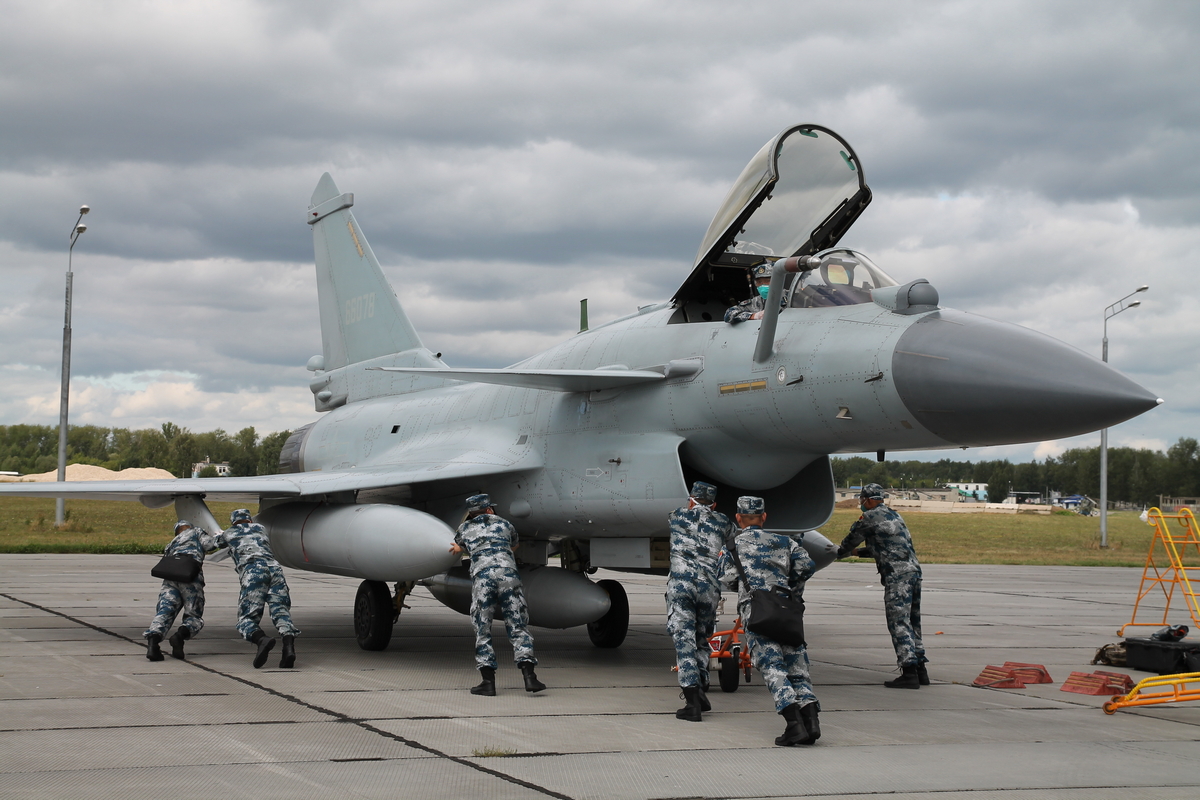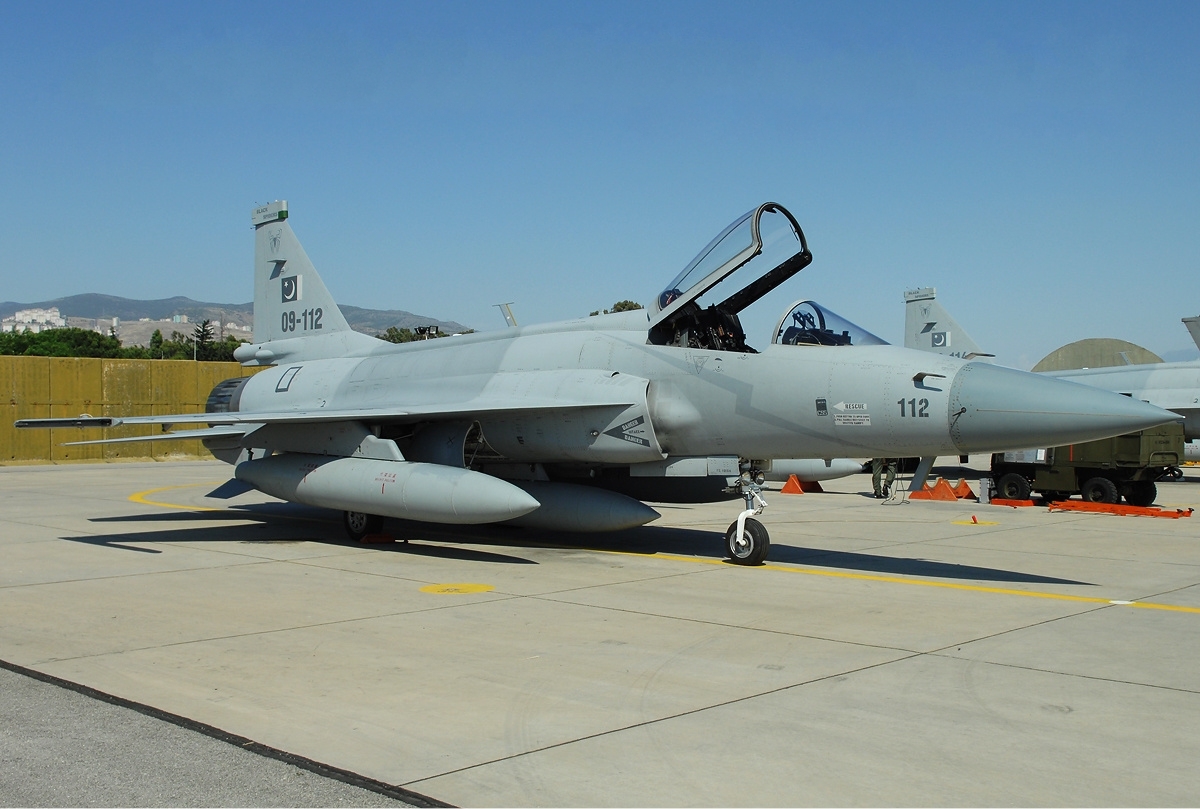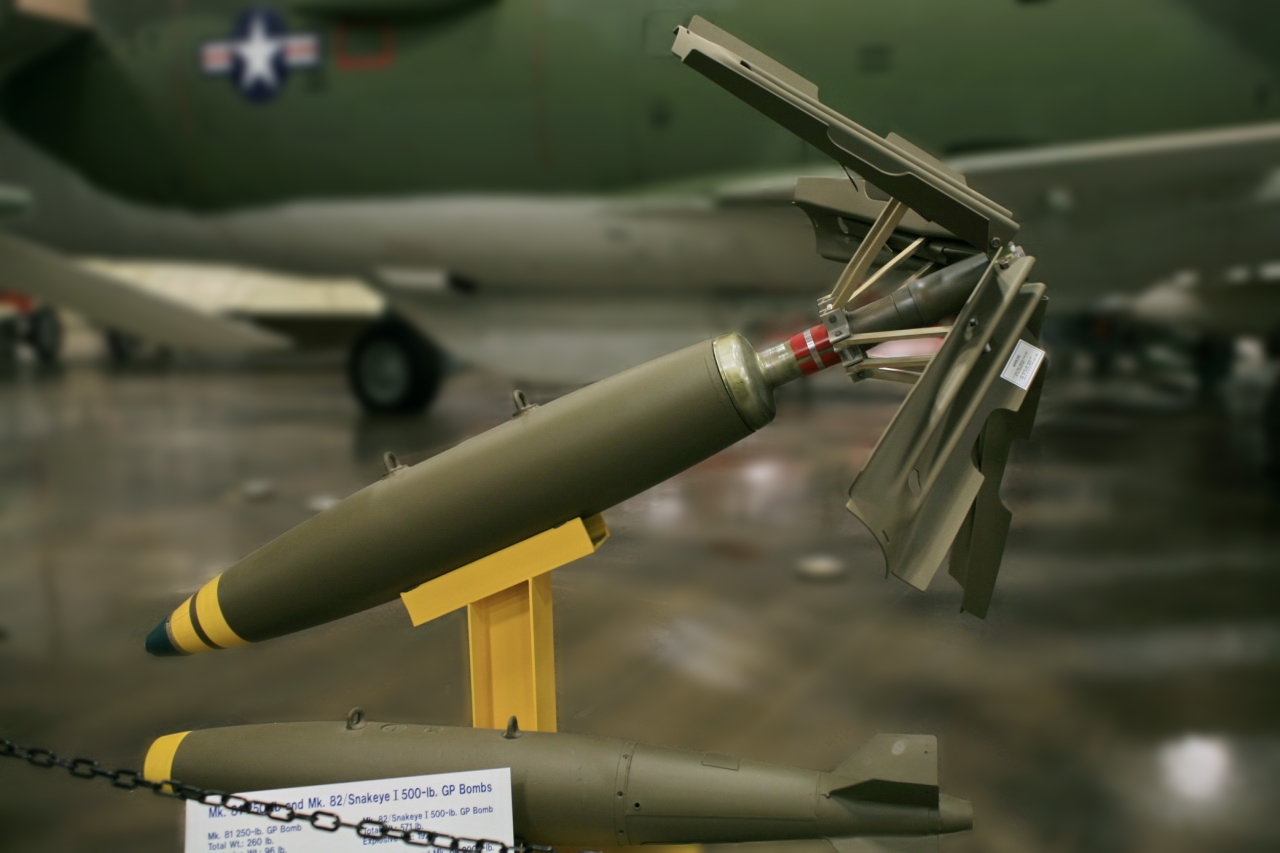|
Al Battaar
The Al-Battaar is a series of laser-guided bombs (LGBs) developed in Pakistan by Qaswa Industries (aka Air Weapons Complex). It is one of Pakistan's first locally developed Precision Guided Munitions (PGM). Overview The Al-Battaar is specifically designed to give high precision and accuracy within a promised 10m CEP. While the kit is made up of several key components, they are classified into two main groups. The Computer Control Group (CCG) installed on the front of the GPB and the Airfoil Group attached to the rear end of the GPB. The Al-Battar being a laser guided weapon relies on an external source to illuminate the target to guide it. This laser illuminator could be a targeting pod on board the launch platform, another aircraft (including drones), or a hand held Laser designator from soldiers or vehicles. The weapon can be launched at a maximum altitude of up to 25,000 ft carried as one or multiple munitions through pylons and bomb-racks. With an operational range of ... [...More Info...] [...Related Items...] OR: [Wikipedia] [Google] [Baidu] |
Precision-guided Munition
A precision-guided munition (PGM), also called a smart weapon, smart munition, or smart bomb, is a type of weapon system that integrates advanced guidance and control systems, such as Global Positioning System, GPS, laser guidance, or Infrared search and track, infrared sensors, with various types of Ammunition, munitions, typically Missile, missiles or Shell (projectile), artillery shells, to allow for high-accuracy strikes against designated Targeting (warfare), targets. PGMs are designed to precisely hit a predetermined target, typically with a margin of error (or circular error probable, CEP) that is far smaller than conventional unguided munitions. Unlike unguided munitions, PGMs use active or passive Control system, control mechanisms capable of steering the weapon towards its intended target. PGMs are capable of mid-flight course corrections, allowing them to adjust and hit the intended target even if conditions change. PGMs can be deployed from various platforms, includi ... [...More Info...] [...Related Items...] OR: [Wikipedia] [Google] [Baidu] |
Dive Bomber
A dive bomber is a bomber aircraft that dives directly at its targets in order to provide greater accuracy for the bomb it drops. Diving towards the target simplifies the bomb's trajectory and allows the pilot to keep visual contact throughout the bomb run. This allows attacks on point targets and ships, which were difficult to attack with conventional level bombers, even ''en masse''. Dive bombing was especially effective against vehicles when integrated into early instances of Blitzkrieg. After World War II, the rise of precision-guided munitions and improved anti-aircraft defences—both fixed gunnery positions and fighter interception—led to a fundamental change in dive bombing. New weapons, such as rockets, allowed for better accuracy from smaller dive angles and from greater distances. They could be fitted to almost any aircraft, including fighters, improving their effectiveness without the inherent vulnerabilities of dive bombers, which needed air superiority to ... [...More Info...] [...Related Items...] OR: [Wikipedia] [Google] [Baidu] |
Guided Bombs
A guided bomb (also known as a smart bomb, guided bomb unit, or GBU) is a precision-guided munition designed to achieve a smaller circular error probable (CEP). The creation of precision-guided munitions resulted in the retroactive renaming of older bombs as unguided bombs or "dumb bombs". Guidance Guided bombs carry a guidance system which is usually monitored and controlled from an external device. A guided bomb of a given weight must carry fewer explosives to accommodate the guidance mechanisms. Radio The Germans were first to introduce precision guided munitions (PGMs) in combat, using the 1,400-kg (3,100 lb) MCLOS-guidance Fritz X to successfully attack the Italian battleship ''Roma'' in September 1943. The closest Allied equivalents were the 1,000-lb (454 kg) AZON (AZimuth ONly), used in both Europe and the CBI Theater, and the US Navy's Bat, primarily used in the Pacific Theater of World War II which used autonomous, on-board radar guidance. In ... [...More Info...] [...Related Items...] OR: [Wikipedia] [Google] [Baidu] |
GIDS Products
GIDS or Gids may refer to: * De Gids, Dutch literary periodical * Global Industrial Defence Solutions, a Pakistani arms company * Graduate Institute of Development Studies, educational institute in Switzerland * NHS Gender Identity Development Service, a UK clinic for children with gender identity issues * Graded Intergenerational Disruption Scale Joshua Fishman (Yiddish: שיקל פֿישמאַן — Shikl Fishman; July 18, 1926 – March 1, 2015) was an American linguist who specialized in the sociology of language, language planning, bilingual education, and language and ethnicity ..., used for measuring language vitality See also * GID (other) {{disambiguation ... [...More Info...] [...Related Items...] OR: [Wikipedia] [Google] [Baidu] |
JDAM
The Joint Direct Attack Munition (JDAM) is a guidance kit that converts unguided bombs, or "dumb bombs", into all-weather precision-guided munitions (PGMs). JDAM-equipped bombs are guided by an integrated inertial guidance system coupled to a Global Positioning System (GPS) receiver, giving them a published range of up to . JDAM-equipped bombs range from . The JDAM's guidance system was jointly developed by the United States Air Force and United States Navy, hence the "joint" in JDAM. When installed on a bomb, the JDAM kit is given a GBU (Guided Bomb Unit) identifier, superseding the Mark 80 or BLU (Bomb, Live Unit) nomenclature of the bomb to which it is attached. The JDAM is not a stand-alone weapon; rather it is a "bolt-on" guidance package that converts unguided gravity bombs into PGMs. The key components of the system are a tail section with aerodynamic control surfaces, a (body) strake kit, and a combined inertial guidance system and GPS guidance control unit. The JDAM w ... [...More Info...] [...Related Items...] OR: [Wikipedia] [Google] [Baidu] |
Paveway
Paveway is a series of laser-guided bombs (LGBs). ''Pave'' or PAVE is sometimes used as an acronym for ''precision avionics vectoring equipment''; literally, electronics for controlling the speed and direction of aircraft. Laser guidance is a form of Pave. Pave, paired with other words, is the first name for various laser systems that designate targets for LGBs, for example Pave Penny, Pave Spike, Pave Tack and Pave Knife, and for specialized military aircraft, such as AC-130U Pave Spectre, MH-53 Pave Low, and HH-60 Pave Hawk. Development The Paveway series of laser-guided bombs was developed by Texas Instruments, with the project starting in 1964. The program was conducted on a shoestring budget, but the resultant emphasis on simplicity and economical engineering proved to be a benefit, and a major advantage over other more complex guided weapons. The first test, using a M117 bomb as the warhead, took place in April 1965. Early version featured aerodynamic designs ... [...More Info...] [...Related Items...] OR: [Wikipedia] [Google] [Baidu] |
Baykar Bayraktar Akıncı
Bayraktar Akıncı (, Raider lit. "Akinji") is a high-altitude long-endurance (HALE) unmanned combat aerial vehicle (UCAV) being manufactured by the Turkish defence company Baykar. The first three units entered service with the Turkish Armed Forces on 29 August 2021. The aircraft has a 5.5+ ton maximum takeoff weight (MTOW), of which over is payload. ''Akıncı'' is equipped with two turboprop engines of either or , as well as electronic support and electronic countermeasures, ECM systems, dual Communications satellite, satellite communication systems, air-to-air radar, collision avoidance radar, and advanced synthetic-aperture radar. Development With the preliminary design phase completed in June 2019, ''Akıncı'' started engine ground run testing in August 2019 with a Ukraine, Ukrainian Ivchenko-Progress AI-450C turboprop engine. First engine test was accomplished on September 1, 2019. Following the completion of other technical tests, the aircraft was moved to the Turk ... [...More Info...] [...Related Items...] OR: [Wikipedia] [Google] [Baidu] |
Mirage V
The Dassault Mirage 5 is a French supersonic attack aircraft/fighter-bomber designed by Dassault Aviation during the 1960s and manufactured in France and other countries. It was derived from Dassault's popular Mirage III fighter and spawned several variants of its own, including the IAI Kfir. In Pakistan's service, the Mirage 5s are modified and are capable of nuclear weapons delivery. Design and development Early development The Mirage 5 grew out of a request to Dassault from the Israeli Air Force. Since the weather over the Middle East is clear and sunny most of the time, the Israelis suggested removing the air intercept radar and its avionics, normally located behind the cockpit, from the standard Mirage IIIE to reduce cost and maintenance, and replacing them with more fuel storage for attack missions.Duchateau/Salvador 1990, p. 26.Jackson 1985, pp. 32–34. In September 1966, the Israelis placed an order for 50 of the new aircraft. Due to customer preference some variants ... [...More Info...] [...Related Items...] OR: [Wikipedia] [Google] [Baidu] |
J-10C
The Chengdu J-10 Vigorous Dragon (; NATO reporting name: Firebird) is a Chinese medium-weight, single-engine, multirole combat aircraft using a delta wing and canard design, with a maximum speed of Mach 1.8. It is produced by the Chengdu Aircraft Corporation (CAC) for the People's Liberation Army Air Force (PLAAF) and People's Liberation Army Naval Air Force (PLANAF) of China, and exported to the Pakistan Air Force (PAF). The J-10 is mainly designed for air-to-air combat, but can also perform strike missions. Development In 1981, PLAAF Commander Zhang Tingfa submitted a proposal to Deng Xiaoping for the development of a third-generation fighter for ; it was accepted later that year by the Central Military Commission (CMC). It was the first Chinese aircraft program to incorporate modern development and acquisition processes.''Research, Development, and Acquisition'', page 2 In one departure from the past, the supplier was now responsible directly to the customer; this allo ... [...More Info...] [...Related Items...] OR: [Wikipedia] [Google] [Baidu] |
JF-17
The CAC/PAC JF-17 Thunder (), or FC-1 ''Xiaolong'' (), is a fourth-generation, lightweight, single-engine, multirole combat aircraft developed jointly by the Pakistan Aeronautical Complex (PAC) and Chengdu Aircraft Corporation (CAC) of China. It was designed and developed as a replacement for the third-generation A-5C, F-7P/PG, Mirage III, and Mirage 5 combat aircraft in the Pakistan Air Force (PAF). The JF-17 can be used for multiple roles, including interception, ground attack, anti-ship, and aerial reconnaissance. The Pakistani designation "JF-17" stands for "Joint Fighter-17", with the "Joint Fighter" denoting the joint Pakistani-Chinese development of the aircraft and the "-17" denoting that, in the PAF's vision, it is the successor to the F-16. The Chinese designation "FC-1" stands for "Fighter China-1". The JF-17 can deploy diverse ordnance, including air-to-air, air-to-surface, and anti-ship missiles, guided and unguided bombs, and a 23 mm GSh-23-2 twin- ... [...More Info...] [...Related Items...] OR: [Wikipedia] [Google] [Baidu] |
Mk 84
The Mark 84 or BLU-117 is a American general purpose aircraft bomb. It is the largest of the Mark 80 series of weapons. Entering service during the Vietnam War, it became a commonly used US heavy unguided bomb. At the time, it was the third largest bomb by weight in the US inventory behind the BLU-82 "Daisy Cutter" and the M118 "demolition" bomb. It is currently sixth in size due to the addition of the GBU-28 in 1991, the GBU-43/B Massive Ordnance Air Blast bomb (MOAB) in 2003, and the GBU-57A/B Massive Ordnance Penetrator (MOP). Development and use The Mark 84 has a nominal weight of , but its actual weight varies depending on its fin, fuze options, and retardation configuration, from . It is a streamlined steel casing filled with of tritonal high explosive. The Mark 84 can form a crater wide and deep. It can penetrate up to of metal or of concrete, depending on the height from which it is dropped, and causes lethal fragmentation to a radius of . Many Mark 84 ... [...More Info...] [...Related Items...] OR: [Wikipedia] [Google] [Baidu] |
Mk 82
The Mark 82 is a unguided, low- drag general-purpose bomb, part of the United States Mark 80 series. The explosive filling is usually tritonal, though other compositions have sometimes been used. Development and deployment With a nominal weight of , it is one of the smallest bombs in current service, and one of the most common air-dropped weapons in the world. Although the nominal weight is , its actual weight varies depending on its configuration, from . It is a streamlined steel casing containing of Tritonal high explosive. The is offered with a variety of fin kits, fuzes, and retarders for different purposes. The is the warhead for the GBU-12 laser-guided bombs and for the GBU-38 JDAM. Over many years Nitro-Chem in Bydgoszcz, Poland was the only provider of certified TNT for U.S. Department of Defense. As of 2021 also the General Dynamics plant in Garland, Texas was providing bombs for the US Armed Forces. The is currently undergoing a minor redesign to allow ... [...More Info...] [...Related Items...] OR: [Wikipedia] [Google] [Baidu] |







